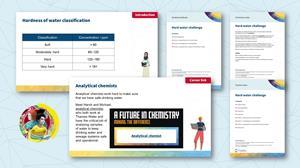Investigate the relationship between the concentration of calcium ions and the ‘hardness’ of water
This project should take approximately four hours to complete in full. The activities were initially created for 14–16 year-old learners but can be adapted for other age groups.
Use the resource in a sequence of timetabled lessons, science clubs or during an activity day.
Learning objectives
- Explain the construction and use of a look-up chart.
- Follow instructions for carrying out a procedure to test hard water.
- Compare the effectiveness of different water filters.
- Describe the domestic and health issues associated with hard water.
Guidance notes
In this series of activities, learners will work in pairs or groups of three to investigate the relationship between the concentration of calcium ions and the ‘hardness’ of samples of water.
Use slides 3–7 of the PowerPoint to introduce what ’hardness of water’ means and how this can be tested.

This resource was developed as part of the Chemistry for All project. The project was set up to explore and address barriers to participation in UK chemistry undergraduate study through a longitudinal project. Read the findings relevant to teachers, outreach providers, education policymakers and parents in the summary report, or download the full research report.
Activity 1: measuring calcium concentrations
In Activity 1, learners will measure the concentration of calcium ions, in parts per million (ppm), of several solutions and assess their ‘hardness’ by adding a coloured indicator and a reagent called ethylenediaminetetraacetic acid (EDTA). They will then use their results to create a look-up chart. Find the method and questions in the student workbook.
Activity 2: investigating ion-exchange filters
Activity 2 requires the learners to investigate how effectively various water filters remove calcium ions from a sample of calcium chloride with a concentration of 500 ppm. They will do this by determining the calcium ion concentration after the samples have been filtered using their look-up charts. Use slides 10 and 11 of the PowerPoint to introduce the use of water filters and show some career links.
More resources
- Introduce learners to Joseph, a laboratory analyst and higher degree apprentice, who works at Thames Water and carries out vital safety tests on drinking water for 15 million people.
- Display the infographic poster and download the resources to get learners constructing their own model of the water cycle.
- Use a microbiology practical to investigate the Antibacterial properties of the halogens and link to UN sustainable development goal 6: clean water and sanitation.
- Do the Global experiment on water and hydrogels to challenge your students to answer the question: are we wasting water?
Activity 3: using dipsticks to measure the hardness of water
In Activity 3, the learners will confirm their results using commercially available dipsticks which can show the hardness of water samples in a very short time. The instructions for dipsticks tend to vary, so follow the instructions provided on the packaging.
Find the answers to all the activities in the teacher notes and on the slides.
Careers
The Chemistry for All project found that recognising the value and importance of chemistry, and appreciating how it can lead to interesting and well-paid jobs strongly related to learners’ future aspirations.
Use the job profiles embedded in the PowerPoint to introduce learners to scientists who use their chemistry skills, knowledge and qualifications in their careers. Share our careers website, A Future in Chemistry, with learners to discover the different study options available to them, find more videos of chemists making a difference and try our career options game.
Health and safety
Read our health and safety guidance and carry out a risk assessment before running any live practical. Specific safety advice for the chemicals used in this project can be found in the technician notes.
The safety equipment suggested is in line with CLEAPSS requirements. For non-hazardous substances, wearing lab coats can help to protect clothes. The safety rules might be different where you live so it is worth checking local and school guidance.
Find more projects like this, plus shorter activities suitable for single science lessons or clubs on our Outreach resources hub.
Downloads
Hard water challenge student workbook
Editable handout | Word, Size 0.66 mbHard water challenge student workbook
Handout | PDF, Size 0.57 mbHard water challenge teacher notes
Editable handout | Word, Size 0.48 mbHard water challenge teacher notes
Handout | PDF, Size 0.54 mbHard water challenge technician notes
Editable handout | Word, Size 0.49 mbHard water challenge technician notes
Handout | PDF, Size 0.41 mbHard water challenge presentation slides
Presentation | PowerPoint, Size 2.46 mbHard water challenge presentation slides
Presentation | PDF, Size 1.39 mb
Additional information
This resource was originally developed by Nottingham Trent University to support outreach work delivered as part of the Chemistry for All project.
Chemistry for All project resources
- 1
- 2
- 3
 Currently reading
Currently readingHard water challenge
- 4
- 5
- 6





















2 readers' comments